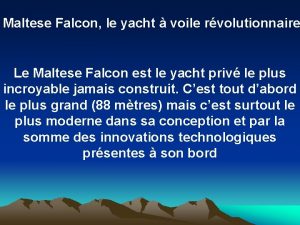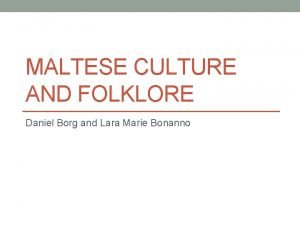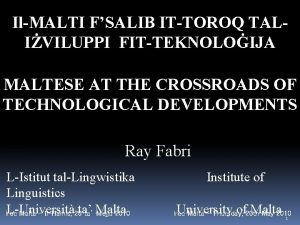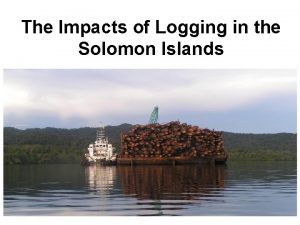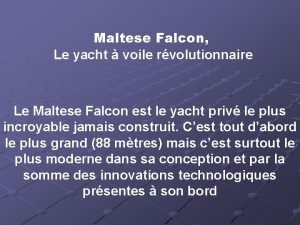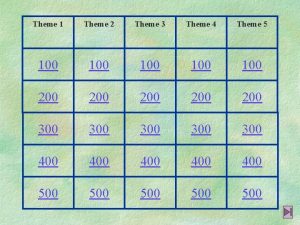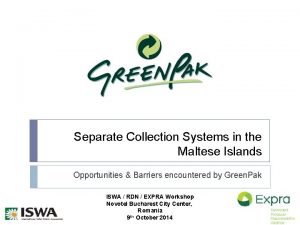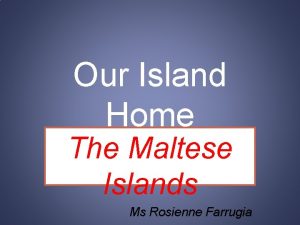Agriculture in the Maltese Islands Theme 2 History














- Slides: 14

Agriculture in the Maltese Islands Theme 2

History of Agriculture After the Ice Age some 10, 000 years ago, the climate was getting warmer. As the ice melted, it was possible for man to grow crops such as barley and wheat. This is perhaps of the greatest revolutions in the story of man. The Nomad now became a Neolithic man whereby it was essential for him to settle down and form a community. Now man had a staple food supply which could be stored for a very long time. This gave him extra time on his hands which he used to create tools and jewellery.

• What is agriculture? • What is the difference between arable and pastoral farming? • Which are the physical and human factors which affect the different types of agriculture? • What is the difference between intensive and extensive farming practices? • What is commercial farming? • What is subsistence farming?

Agriculture The science, art, or practice of cultivating the soil, producing crops, and raising livestock (animals) and in varying degrees the preparation and marketing of the resulting products.

Three types of farming • Arable – the growing of fruit and vegetables • Pastoral – animal husbandry • Mixed – mixture of both

Physical factors affecting agriculture • Climate – different climates allow for different fruits and vegetables to be grown. For instance while it is possible to grow bananas in tropical regions. Whereby they require moist soil with good drainage, it is not possible to have them in dry regions. • Relief – how flat or steep the land is also makes a big difference. Flat land is usually the preferred type for the growing of crops, meanwhile the steep sided slopes is used for grazing. • Soil – the fertility of the soil is another determining factor, the most fertile of soils are usually found in the floodplains, or in the case of Malta in the valleys. This is the preferred type for the growing of crops, meanwhile less fertile soil is used for grazing or otherwise to plant trees such as olive trees.

Human factors affecting agriculture • Capital – how much money you have available to invest in the necessary machinery, land crops. • • Labour – the amount of people you have available to work with. Market – the demand for the products which you are producing. Politics – how much the government is willing to support farmers. Land tenure – in times when the farmer is the owner of the agricultural land more investment is made with regards to machinery, soil cultivation and maintenance of rubble walls.

Different types of farming • • Intensive farming – large amounts of labour/small land area Extensive farming – small amounts of labour/large land areas Commercial farms – producing products which will sell at a profit Subsistence farms – producing products to meet the needs of the farmer and the community

Farming history in Malta • Neolithic Man which came from Sicily brought with him the necessary tools, crops and animals needed to enable him to cultivate the land. • Roman times – production of olive oil (olive presses found in the Roman Villas) and honey (Migbha) • Terraced fields – created thanks to the rubble walls to make use of all the available arable land • The Arabs – Citrus trees such as oranges and lemons • The Knights – big cotton industry (cash crops)

• What are the major challenges faced by Maltese farmers today? • What do they do to combat these challenges? • What role does the Government and the EU play? • What is organic farming? • What impact does organic farming have on the natural environment?

Farming in Malta today There are several challenges which Maltese farmers face today namely: • Size of the fields – very small making it almost impossible for farmers to make use of machinery thus it is very labour intensive • Climatic conditions – very dry and lack of available fresh water • Maltese soils – relatively young and prone to erosion by wind and water (heavy rainfall), dry conditions also make the soil more vulnerable to erosion • Farming population always on the decline

Farming in Malta today In order to combat these challenges Maltese farmers adopt the following measures: • Maintenance of rubble walls – to help protect their crops and soils from erosion by the wind and rain • Crop rotation – to help protect the soil from erosion • Reservoirs, reverse osmosis, boreholes to pump water from the upper and lower water table • Drip irrigation – to use only the exact amount of water needed • EU funds to help develop and become more efficient in a way that they can compete with foreign competition

Organic Farming Organic farming is a form of agriculture that relies on techniques such as: • • • crop rotation, Intercropping, Compost – waste management biological pest control – beneficial insects Farm animals which produce manure

Positive impacts of organic farming on the environment • Ecosystem – flora and fauna diversity • Soil – better quality soil • Water level – uses less water and leaves behind clean fresh water free from any pesticides • Climate and air – better quality air and less impact on climate change since no harmful gases are being emitted in the air • Man/animals health – elimination of health related diseases • Waste management – less waste since most of it used for natural fertilisers
